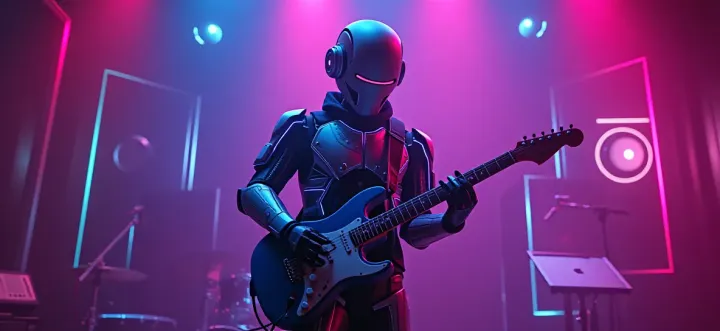The Rise of Synthwave: A Neon-Soaked Journey Through Time
Synthwave emerged as a powerful homage to the 1980s, capturing not just the sound but the entire cultural zeitgeist of that decade. Born in the mid-2000s, this electronic music genre became a gateway to an idealized version of the 80s that never existed but lived in our dreams.
The Rise of Synthwave: A Neon-Soaked Journey Through Time
In the neon-lit corridors of musical history, synthwave emerged as a powerful homage to the 1980s, capturing not just the sound but the entire aesthetic and cultural zeitgeist of that transformative decade. Born in the mid-2000s, this electronic music genre would grow to become much more than just a style of music – it became a gateway to an idealized version of the 1980s that never truly existed but always lived in our collective imagination.
The Origins (2005-2010)
Synthwave's story begins around 2005, with early pioneers like Kavinsky and Justice creating music that drew heavily from 1980s film soundtracks and video game music. The genre initially took shape in the French house scene, where producers began experimenting with vintage synthesizers and drum machines that defined the 80s sound – equipment like the Roland Jupiter-8, the Yamaha DX7, and the iconic LinnDrum.
The real catalyst came in 2007 when Kavinsky released "Testarossa Autodrive," a track that would become one of the foundational pieces of the synthwave movement. Named after the Ferrari Testarossa, the song embodied everything that would come to define the genre: crisp synthesizer melodies, driving basslines, and an unmistakable connection to 1980s pop culture.
The Golden Age (2011-2015)
The early 2010s saw synthwave explode into mainstream consciousness, largely thanks to the 2011 film "Drive" and its iconic soundtrack featuring Kavinsky's "Nightcall." This period gave rise to artists who would become legends within the scene: Perturbator, Carpenter Brut, and Com Truise each brought their unique take on the genre.
During this golden age, synthwave began to splinter into distinct subgenres:
- Outrun: Named after the 1986 arcade game, focusing on car themes and night driving
- Darksynth: A darker, more aggressive variation incorporating horror elements
- Retrowave: A broader term encompassing the more pop-oriented side of the genre
- Dreamwave: Emphasizing ethereal, atmospheric soundscapes
The community grew rapidly through platforms like Bandcamp and SoundCloud, where artists could easily share their music with an increasingly passionate fanbase. Record labels dedicated to synthwave began to emerge, with Rosso Corsa Records and Telefuture leading the charge.
Cultural Impact and Aesthetic Development
Synthwave's influence extended far beyond music. The genre gave birth to a complete aesthetic movement, characterized by:
- Neon color palettes dominated by pink and blue
- Retro-futuristic imagery
- Grid designs and wireframe landscapes
- Sun and palm tree motifs
- Classic cars and angular typography
This visual style would go on to influence fashion, graphic design, and even video games, with titles like "Hotline Miami" and "Far Cry 3: Blood Dragon" embracing the synthwave aesthetic completely.
The Modern Era (2016-Present)
As synthwave matured, it began to influence mainstream music more directly. Modern pop artists started incorporating synthwave elements into their productions, and the genre's influence can be heard in works by The Weeknd, Dua Lipa, and countless others.
The genre has also evolved beyond its initial parameters, with artists like The Midnight, FM-84, and Gunship bringing more sophisticated production techniques and vocal elements to the style. These developments helped synthwave maintain its relevance while staying true to its retro roots.
Legacy and Future
Synthwave's enduring appeal lies in its ability to evoke nostalgia for an era that many of its fans never actually experienced. It represents not the 1980s as they were, but as we wished they had been – a neon-drenched dreamscape of endless possibilities and technological optimism.
The genre continues to evolve, with new artists pushing its boundaries while maintaining the core elements that made it special:
- Analog synthesizer sounds
- Prominent melodic elements
- Driving rhythms
- Strong emotional resonance
- Cultural references to 1980s media
Today, synthwave stands as more than just a musical genre – it's a cultural movement that has helped shape how we remember and reimagine the 1980s. Its influence can be seen in everything from Netflix's "Stranger Things" to modern video game soundtracks, and its aesthetic continues to captivate new generations of artists and fans.
As we move further into the future, synthwave serves as a reminder that sometimes the most innovative art comes from looking backward, not just forward. It shows us that nostalgia, when properly channeled, can create something entirely new and exciting while paying homage to the past that inspired it.
The genre's future seems secure as it continues to attract new artists and fans, each bringing their own interpretation of what the 1980s meant or could have meant. As long as there are dreamers looking to capture that perfect moment of neon-soaked nostalgia, synthwave will continue to evolve and thrive.
Essential Listening
For those looking to explore the genre, these albums represent key moments in synthwave's evolution:
- Kavinsky - "OutRun" (2013)
- College & Electric Youth - "A Real Hero" (2011)
- The Midnight - "Days of Thunder" (2014)
- FM-84 - "Atlas" (2016)
- Carpenter Brut - "Trilogy" (2015)
- Perturbator - "Dangerous Days" (2014)
- Gunship - "Gunship" (2015)
These recordings showcase the diversity within synthwave while highlighting the common threads that bind the genre together. Each represents a different facet of what makes synthwave special, from pure instrumental works to vocal-driven synthpop evolution.



